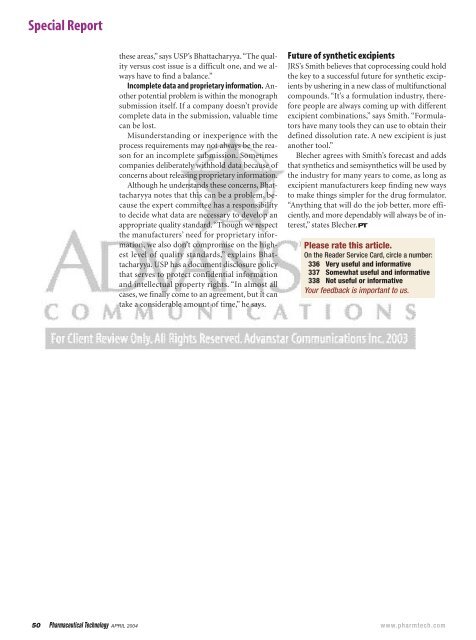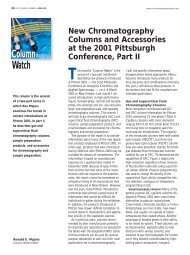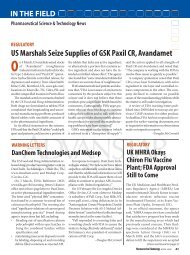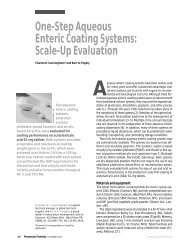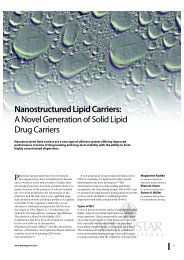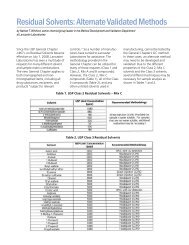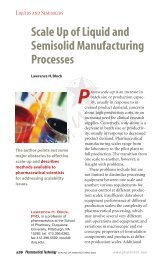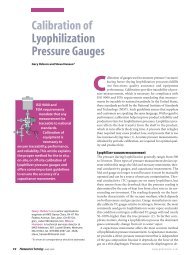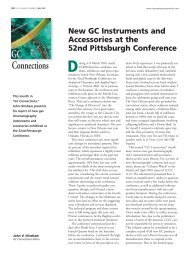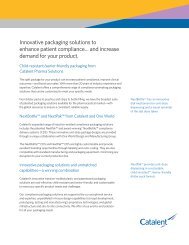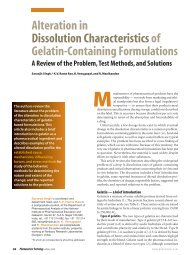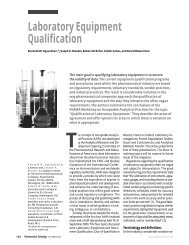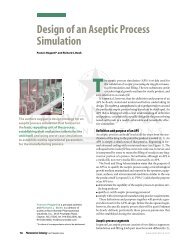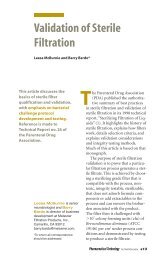Synthetic Excipients Challenge All-Natural Organics Synthetic ...
Synthetic Excipients Challenge All-Natural Organics Synthetic ...
Synthetic Excipients Challenge All-Natural Organics Synthetic ...
Create successful ePaper yourself
Turn your PDF publications into a flip-book with our unique Google optimized e-Paper software.
Special Report<br />
these areas,” says USP’s Bhattacharyya.“The quality<br />
versus cost issue is a difficult one, and we always<br />
have to find a balance.”<br />
Incomplete data and proprietary information. Another<br />
potential problem is within the monograph<br />
submission itself. If a company doesn’t provide<br />
complete data in the submission, valuable time<br />
can be lost.<br />
Misunderstanding or inexperience with the<br />
process requirements may not always be the reason<br />
for an incomplete submission. Sometimes<br />
companies deliberately withhold data because of<br />
concerns about releasing proprietary information.<br />
Although he understands these concerns, Bhattacharyya<br />
notes that this can be a problem, because<br />
the expert committee has a responsibility<br />
to decide what data are necessary to develop an<br />
appropriate quality standard.“Though we respect<br />
the manufacturers’ need for proprietary information,<br />
we also don’t compromise on the highest<br />
level of quality standards,” explains Bhattacharyya.<br />
USP has a document disclosure policy<br />
that serves to protect confidential information<br />
and intellectual property rights. “In almost all<br />
cases, we finally come to an agreement, but it can<br />
take a considerable amount of time,” he says.<br />
Future of synthetic excipients<br />
JRS’s Smith believes that coprocessing could hold<br />
the key to a successful future for synthetic excipients<br />
by ushering in a new class of multifunctional<br />
compounds. “It’s a formulation industry, therefore<br />
people are always coming up with different<br />
excipient combinations,” says Smith. “Formulators<br />
have many tools they can use to obtain their<br />
defined dissolution rate. A new excipient is just<br />
another tool.”<br />
Blecher agrees with Smith’s forecast and adds<br />
that synthetics and semisynthetics will be used by<br />
the industry for many years to come, as long as<br />
excipient manufacturers keep finding new ways<br />
to make things simpler for the drug formulator.<br />
“Anything that will do the job better, more efficiently,<br />
and more dependably will always be of interest,”<br />
states Blecher.PT<br />
Please rate this article.<br />
On the Reader Service Card, circle a number:<br />
336 Very useful and informative<br />
337 Somewhat useful and informative<br />
338 Not useful or informative<br />
Your feedback is important to us.<br />
50 Pharmaceutical Technology APRIL 2004 www.pharmtech.com


